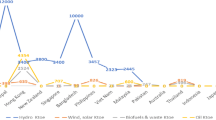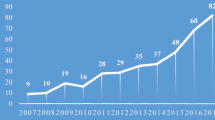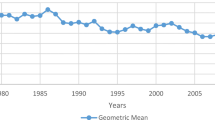Abstract
This paper presents an assessment of energy performance in South Africa from 1965 to 2014 using the technique for order of preference by similarity to ideal solution (TOPSIS). In this research, TOPSIS is used first in a two-stage approach to assess how energy in South Africa has performed using the most frequent indicators adopted by the literature. Afterwards, in the second stage, neural networks are combined with TOPSIS results as part of an attempt to produce a model for energy performance with good predictive ability. The results reveal different impacts of contextual variables such as the rise of China in foreign trade, the Apartheid Regime, and oil shocks on energy performance in South Africa.








Similar content being viewed by others
References
Afshar, A., Mariño, M. A., Saadatpour, M., & Afshar, A. (2011). Fuzzy TOPSIS multicriteria decision analysis applied to karun reservoirs system. Water Resource Management, 25, 545–563.
Afsordegan, A., Sánchez, M., Agell, N., Zahedi, S., & Cremades, L. V. (2016). International Journal of Environmental Science and Technology, 13(6), 1419–1432.
Apergis, N., Aye, G. C., Barros, C. P., Gupta, R., & Wanke, P. (2015). Energy efficiency of selected OECD countries: A slacks based model with undesirable outputs. Energy Economics, 51, 45–53.
Azadeh, A., Sheikhalishahi, M., & Boostani, A. (2014). A flexible neuro-fuzzy approach for improvement of seasonal housing price estimation in uncertain and non-linear environments. South African Journal of Economics, 82(4), 567–582.
Banker, R. D., Charnes, A., & Cooper, W. W. (1984). Some models for estimating technical and scale inefficiencies in data envelopment analysis. Management Science, 30(9), 1078–1092.
Barros, C. P., & Wanke, P. (2015). An analysis of African airlines efficiency with two-stage TOPSIS and neural networks. Journal of Air Transport Management, 44–45, 90–102. https://doi.org/10.1016/j.jairtraman.2015.03.002.
Behzadian, M., Otaghsara, S. K., Yazdani, M., & Ignatius, J. (2012). A state-of the-art survey of TOPSIS applications. Expert Systems with Applications, 39(17), 13051–13069.
Bilbao-Terol, A., Arenas-Parra, M., & Cañal Fernandes, V. (2014). Using Topsis for assessing the sustainability of government bond funds. Omega, 49, 1–17. https://doi.org/10.1016/j.omega.2014.04.005.
Bishop, CM, 1995, Neural networks for pattern recognition, Oxford University Press.
Boran, F. E., Genç, S., Kurt, M. and Akay, D. (2011). Personnel selection based on intuitionistic fuzzy sets. Human Factors and Ergonomics in Manufacturing & Service Industries, 1–11.
Brans, J. P., & Vincke, P. H. (1985). A preference ranking organization method: The Promethee method. Management Science, 31, 647–656.
Bulgurcu, B. K. (2012). Application of TOPSIS technique for financial performance evaluation of technology firms in Istanbul stock exchange market. Procedia - Social and Behavioral Sciences, 62(24), 1033–1040.
Chamodrakas, I. & Martakos, D. (2012). A utility-based fuzzy TOPSIS method for energy efficient network selection in heterogeneous wireless networks. Applied Soft Computing, 12(7),1929–1938.
Charnes, A., Cooper, W. W., & Rhodes, E. (1978). Measuring efficiency of decision making units. European Journal of Operational Research, 2(6), 429–444.
Chen, M.-C. (2007). Ranking discovered rules from data mining with multiple criteria by data envelopment analysis. Expert Systems with Applications, 33(4), 1110–1116.
Chen, T.-Y. (2002). A comparison of chance-constrained DEA and stochastic frontier analysis: bank efficiency in Taiwan. Journal of the Operational Research Society, 53(5), 492–500.
Chen, Y.-S., & Cheng, C.-H. (2013). Hybrid models based on rough set classifiers for setting credit rating decision rules in the global banking industry. Knowledge-Based Systems, 39, 224–239.
Chen, F.-H., Chi, D.-J., & Wang, Y.-C. (2015). Detecting biotechnology industry’s earnings management using Bayesian network, principal component analysis, back propagation neural network, and decision tree. Economic Modelling, 46, 1–10.
Chen, S., Leng, Y., Mao, B., & Liu, S. (2014). Integrated weight-based multi-criteria evaluation on transfer in large transport terminals: A case study of the Beijing South Railway Station. Transportation Research Part A: Policy and Practice, 66, 13–26.
Chen, C. T., Lin, C. T., & Huang, S. F. (2006). A fuzzy approach for supplier evaluation and selection in supply chain management. International Journal of Production Economics, 102, 289–301.
Claveria, O., & Torra, S. (2014). Forecasting tourism demand to Catalonia: neural networks vs. time series models. Economic Modelling, 36, 220–228.
Corrente, S., Greco, S., & Slowinski, R. (2013). Multiple criteria hierarchy process with electre and promethee. Omega, 41(5), 820–840. https://doi.org/10.1016/j.omega.2012.10.009.
Daraio, C. et al. (2010). Testing whether two-stage estimation is meaningful in nonparametric models of production. Discussion Paper #1031, Institut de Statistique, UCL, Belgium.
Department of Energy (DOE), 2014. 12L Regulations in relation to the national energy efficiency strategy.
Department of Minerals and Energy (2005). Energy Efficiency Strategy of the Republic of South Africa. www.un-page.org/file/1520/download?token=vyGMOOEW. Accessed 6 Mar 2018.
Ertugrul, I., & Karakasoglu, N. (2009). Performance evaluation of Turkish cement firms with fuzzy analytic hierarchy process and TOPSIS methods. Expert Systems with Applications, 36(1), 702–715.
Faraway, J. J. (2006). Extending the linear model with R: Generalized lienar, mixed effects and nonparametric regression models. Boca Raton: Chapman & Hall/CRC.
Fawkes, H. (2005). Energy efficiency in South African industry. Journal of Energy in Southern Africa, 16(4), 18–25.
Feng, C.-M., & Wang, R.-T. (2001). Considering the financial ratios on the performance evaluation of highway bus industry. Transport Reviews, 21(4), 449–467.
Feng, L., & Zhang, J. (2014). Application of artificial neural networks in tendency forecasting of economic growth. Economic Modelling, 40, 76–80.
Geisser, S. (1993). Predictive inference: An introduction. New York: Chapman & Hall.
Gomez-Lopez, M. D., Bayo, J., Garcia-Cascales, M. S., & Angosto, J. M. (2009). Decision support in disinfection technologies for treated wastewater reuse. Journal of Cleaner Production, 17, 1504–1511.
Gouws, P. A., Brent, A. C., & Pierce, W. T. (2012). The contribution of energy efficiency towards the success of industrial organisations in South Africa. South African Journal of Industrial Engineering, 23(2), 57–65.
Hassan, M., Hawas, Y., & Ahmed, K. (2013). A multi-dimensional framework for evaluating the transit service performance. Transportation Research Part A: Policy and Practice, 50, 47–61.
Hatami-Marbini, A., & Tavana, M. (2011). An extension of the Electre 1 method for group decision making under a fuzzy environment. Omega, 39(6), 373–386. https://doi.org/10.1016/j.omega.2010.12.005.
Hemmati, M., Dalghandi, S. A., & Nazari, H. (2013). Measuring relative performance of banking industry using a DEA and TOPSIS. Measurement Science Letters, 3(2), 499–503.
Hwang, C. L., & Yoon, K. (1981). Multiple attribute decision making: methods and applications, a state of the art survey. New York: Springer-Verlag.
Hwang, C.-L., & Yoon, K. (2012). Multiple attribute decision making: methods and applications a state-of-the-art survey (Vol. 186): Springer Science & Business Media.
Inglesi-Lotz, R., & Pouris, A. (2012). Energy efficiency in South Africa: A decomposition exercise. Energy, 42, 113–120.
Inglesi-Lotz, R., & Blignaut, J. (2011). Estimating the price elasticity of demand for electricity by sector in South Africa. South African Journal of Economic and Management Science, 14(4), 449–465.
International Emissions Trading Association, IETA, 2014. South Africa: The world’s carbon markets: a case study guide to emissions trading. http://www.ieta.org/assets/EDFCaseStudyMarch2014/south%20africa%20case%20study%20march%202,014.pdf.
IEA. 2012. Energy balances for non-OECD countries.
IEA, 2013a. World energy outlook, 2013. http://www.worldenergyoutlook.org/.
IEA, 2013b. Energy efficiency market report 2013. Market trends and medium-term prospects. http://www.iea.org/publications/freepublications/publication/energy-efficiency-market-report-2013.html
IEA, 2014. CO2 emissions from fuel combustion IEA Statistics. IEA Highlights (2014 Edition).
IEA, 2015. Energy efficiency in emerging economies (E4) programme. http://www.iea.org/topics/energyefficiency/e4/
Jahanshahloo, G. R., Lotfi, F. H., & Davoodi, A. R. (2009). Extension of TOPSIS for decision-making problems with interval data: Interval efficiency. Mathematical and Computer Modelling, 49(5–6), 1137–1142.
Jefmański, B., & Dudek, A. (2015). The fuzzy TOPSIS method and its implementation in the R programme. Informatyka Ekonomiczna, 1(35), 19–27.
James, G., Witten, D., Hastie, T., & Tibshirani, R. (2013). An introduction to statistical learning with applications in R. New York: Springer.
Kaya, T., & Kahraman, C. (2011). Multi criteria decision making in energy planning using a modified fuzzy TOPSIS methodology. Expert Systems with Applications, 38, 6577–6585.
Kahraman, C., Engin, O., Kabak, O., & Kaya, I. (2009). Information systems outsourcing decisions using a group decision-making approach. Engineering Applications of Artificial Intelligence, 22, 832–841.
Kelemenis, A., Ergazakis, K., & Askounis, D. (2011). Support managers’ selection using an extension of fuzzy TOPSIS. Expert Systems with Applications, 38, 2774–2782.
Kohler, M., 2013. Differential electricity pricing and energy efficiency in South Africa. Economic Research Southern Africa (ERSA) working paper 396 December 2013.
Kuhn, M., & Johnson, K. (2013). Applied predictive modeling. New York: Springer.
Lai, Y. J., Liu, T. Y., & Hwang, C. L. (1994). Topsis for MCDM. European Journal of Operational Research, 76(3), 486–500.
Ledolter, J. (2013). Data mining and business analytics with R. New Jersey: Wiley.
Madeira Junior, A. G., Cardoso Junior, M., Carmen, M., Belderrain, N., Correia, A. R., & Schwanz, S. H. (2012). Multicriteria and multivariate analysis for port performance evaluation. International Journal of Production Economics, 140(1), 450–456.
Mihaiu, D. M., Opreana, A., & Cristescu, M. P. (2010). Efficiency, effectiveness and performance of the public sector. Romanian Journal of Economic Forecasting, 4, 132–147.
Moyo, B. (2012). Infrastructure quality and manufacturing exports in Africa: A firm-level analysis. South African Journal of Economics, 80(3), 367–386.
Munda, G. and Nardo, M. (2003) On the methodological foundations of composite indicators used for ranking countries, OECD/JRC Workshop on composite indicators of country performance, Ispra, Italy, May 12.
Ng, W. L. (2007). A simple classifier for multiple criteria ABC analysis. European Journal of Operational Research, 177(1), 344–353.
OECD 2011. OECD green growth strategies: energy. OECD Publishing.
Olson, D. L. (2004). Comparison of weights in TOPSIS models. Mathematical and Computer Modelling, 40(7–8), 721–727.
Opricovic, S. (1998). Multicriteria optimization of civil engineering systems. Faculty of Civil Engineering: Belgrade.
Opricovic, S., & Tzeng, G. H. (2007). Extended Vikor method in comparison with out-ranking methods. European Journal of Operational Research, 178(2), 514–529.
Osei-Bryson, K.-M., & Ngwenyama, O. (2014). Advances in research methods for information systems research: Data mining, data envelopment analysis, value focused thinking. New York: Springer.
Pearman, A. D. (1977). A weighted maximin and maximax approach to multiple criteria decision making. Operational Research Quarterly, 28(3), 584–587.
Pirdavani, A., Brijs, T., & Geert, W. (2010). A multiple criteria decision-making approach for prioritizing accident hotspots in the absence of crash data. Transport Reviews, 30(1), 2010.
Ramanathan, U. (2013). Aligning supply chain collaboration using analytical hierarchy process. Omega, 41(2), 431–440.
Rao, P. V., & Baral, S. S. (2011). Attribute based specification, comparison and selection of feed stock for anaerobic digestion using MADM approach. Journal of Hazardous Materials, 186, 2009–2016.
Ripley, B. (1995). Statistical ideas for selecting network architectures. In B. Kappen & S. Gielen (Eds.), Neural Networks: Artificial Intelligence and Industrial Applications: Proceedings of the Third Annual SNN Symposium on Neural Networks, Nijmegen, The Netherlands, 14–15 September 1995 (pp. 183–190). London: Springer.
Saaty, T. L. (1980). The analytical hierarchy process. New York: MacGraw Hill.
Seçme, N. Y., Bayrakdaroglu, A., & Kahraman, G. (2009). Fuzzy performance evaluation in Turkish banking sector using analytic hierarchy process and TOPSIS. Expert Systems with Applications, 36(9), 11699–11709.
Shaverdi, M., Akbari, M., & Tafti, S. F. (2011). Combining fuzzy MCDM with BSC approach in performance evaluation of Iranian private banking sector. Advances in Fuzzy Systems, 2011, 1–11.
Siskos, E., Askounis, D., & Psarras, J. (2014). Multicriteria decision support for global e-governing evaluation. Omega, 46, 51–63. https://doi.org/10.1016/j.omega.2014.02.001.
Song, M.-L., Zhang, L.-L., Liu, W., & Fisher, R. (2013). Bootstrap-DEA analysis of BRICS’ energy efficiency based on small sample data. Applied Energy, 112, 1049–1055.
State of Logistics Survey, South Africa (2013).
Statistics South Africa, 2015.
Talley, W. K. (2007). Port performance: An Economics Perspective. In Devolution, Port Governance and Port Performance, Brooks and Cullinane (Eds). Research in Transportation Economics, 17, 499–516.
Tavana, M., Zandi, F., & Katehakis, M. N. (2013). A hybrid fuzzy group ANP–TOPSIS framework for assessment of e-government readiness from a CiRM perspective. Information & Management, 50(7), 383–397.
Titterington, M. (2010). Neural Networks. Wiley Interdisciplinary Reviews: Computational Statistics, 2(1), 1–8.
Torgo, L. (2011). Data mining with R: Learning with case atudies. Boca Raton: CRC Press.
Tsay, W. H., Chou, W. C., & Hsu, W. (2009). The sustainability balanced scorecard as a framework for selecting social responsible investments: An effective MCDM model. The Journal of the Operational Research Society, 60(10), 1396–1410. https://doi.org/10.1057/jors.2008.91.
Tsui, E., Garner, B. J., & Staab, S. (2000). The role of artificial intelligence in knowledge management. Knowledge-Based Systems, 13(5), 235–239. https://doi.org/10.1016/S0950-7051(00)00093-9.
UNEP (United Nations Environment Programme). (2011). Decoupling and sustainable resource management: scoping the challenges. Paris: UNEP.
Wang, B., Nistor, I., Murty, T., & Wei, Y. M. (2014). Efficiency assessment of hydroelectric power plants in Canada: A multi criteria decision approach. Energy Economics, 46, 112–121.
Wanke, P., Azad, M. A. K., Barros, C. P., & Hadi-Vencheh, A. (2015a). Predicting performance in ASEAN banks: An integrated fuzzy MCDM–neural network approach. Expert Systems, Article first published online: 18 DEC 2015. doi:https://doi.org/10.1111/exsy.12144
Wanke, P., Pestana Barros, C., & Chen, Z. (2015b). An analysis of Asian airlines efficiency with two-stage TOPSIS and MCMC generalized linear mixed models. International Journal of Production Economics, 169, 110–126. https://doi.org/10.1016/j.ijpe.2015.07.028.
Wanke, P., Azad, M. D., Abul, K., & Barros, C. P. (2016). Efficiency factors in OECD banks: A ten-year analysis. Expert Systems with Applications, 64, 208–227.
Winkler, H. & van Es, D. (2007). Energy efficiency and the CDM in South Africa: Constraints and opportunities. Journal of Energy in Southern Africa, 18(1), 29–38.
Wu, C.-S., Lin, C.-T., & Lee, C. (2010). Optimal marketing strategy: A decision-making with ANP and TOPSIS. International Journal of Production Economics, 127(1), 190–196.
Yan, G., Ling, Z., & Dequn, Z. (2011). Performance evaluation of coal enterprises energy conservation and reduction of pollutant emissions base on GRD–TOPSIS. Energy Procedia, 5, 535–539.
Zeydan, M., & Çolpan, C. (2009). A new decision support system for performance measurement using combined fuzzy TOPSIS/DEA approach. International Journal of Production Research, 47(15), 4327–4349.
Zhou, P., Ang, B. W., & Poh, K. L. (2006). Comparing aggregating methods for constructing the composite environmental index: An objective measure. Ecological Economics, 59(3), 305–311.
Zhou, P., & Ang, B. W. (2009). Soc Indic Res, 94, 83. https://doi.org/10.1007/s11205-008-9338-0.
Author information
Authors and Affiliations
Corresponding author
Ethics declarations
Conflict of interest
The authors declare that they have no conflict of interest.
Appendix
Appendix
Rights and permissions
About this article
Cite this article
Aye, G.C., Gupta, R. & Wanke, P. Energy efficiency drivers in South Africa: 1965–2014. Energy Efficiency 11, 1465–1482 (2018). https://doi.org/10.1007/s12053-018-9644-6
Received:
Accepted:
Published:
Issue Date:
DOI: https://doi.org/10.1007/s12053-018-9644-6




